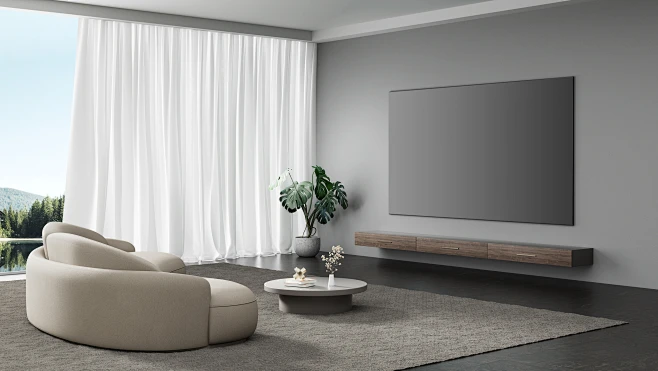
1. Stop Buying Blind! The “Golden Rule” of Projection Screen Size Lies in Viewing Distance
Choosing the sofa position first before picking a screen? It’s a mistake 90% of households worldwide make! The 2025 Global Projection Screen Market Report shows that global demand for home projection screens has reached 31.2 million units, yet over 60% of users compromise their viewing experience due to wrong size choices. Decades ago, two renowned international audio-visual institutions, THX and ISF, revealed the core principle: the right screen size is determined by viewing distance .
2. Understand the Professional Formula in 3 Minutes
The relationship between viewing angle and distance can be calculated by the formula: A=1/2tgα/2 (A = ratio of viewing distance to screen width; α = viewing angle). Under 2025’s latest standards, recommendations from both institutions are better tailored for 4K viewing:
| Aspect Ratio | Recommending Body | Ideal Viewing Angle | Corresponding A Value (Distance/Width) | Application Scenario |
| 16:9 | THX | 40° | 1.37 | 4K movies, gaming |
| 16:9 | ISF | 33° | 1.69 | Daily streaming, live shows |
| 2.35:1 | THX | 52° | 1.03 | Hollywood blockbusters |
| 4:3 | ISF | 25° | 2.26 | Office presentations, online courses |
Lazy Formula: Take the average A value of 1.5, meaning “viewing distance = screen width × 1.5”. For example, a 3-meter viewing distance suits a 2-meter wide 120-inch 16:9 screen.
3. Scene-Based Testing: How to Choose for Different Spaces?
1. Compact Urban Apartment (700 sq. ft. Case)
A New York City tenant used a motorized screen to divide the living and sleeping areas, with a 2.5-meter viewing distance and a custom 100-inch 16:9 screen. “It works as a partition, and my eyes never feel strained during late-night shows.”
👉 Matching Tip: Opt for ultra-thin flexible screens (0.3mm thick) that save space when retracted.

2. Luxury Home Theater (Scottish Estate Case)
A standalone stone cottage was converted into a home theater with a 4-meter depth. Following THX’s A=1.37 standard, a 3.8-meter wide 160-inch acoustically transparent fixed-frame screen was installed . Paired with a Sony 4K laser projector and 9.2.4 audio system, it delivers cinema-level immersion—even with three rows of seating, every spot gets optimal visuals.
3. Corporate Boardroom (3-meter Viewing Distance)
The 4:3 aspect ratio is better for PPTs. A 120-inch screen with an A value of 2.26 ensures everyone (even those in the back row) can read text clearly, avoiding visibility issues in meetings.
4. Q&A: Are You Falling for These Myths?
Q1: The bigger the screen, the more immersive?
A: No! Forcing a 200-inch screen on a 5-meter wide wall with only 3 meters of viewing distance makes your eyes move left and right 15 times per second—leading to dizziness in 30 minutes.
Q2: White screens offer the best value?
A: Not necessarily. Bright living rooms need gray Ambient Light Rejection (ALR) screens, which boost contrast by 40% . Dark home theaters benefit from acoustically transparent screens that hide front speakers behind them without ruining aesthetics .
Q3: Fixed screens are better than motorized ones?
A: For homes, fixed frame screens are preferred—they’re 30% flatter than motorized versions and avoid motor malfunctions. For offices, motorized screens are more practical for switching between meeting modes.
5. 2025 Global Buying Trends
- Customization Goes Mainstream: Demand for curved and circular screens has risen 58%, ideal for gaming rooms and exhibition halls .
- Smart Integration: Screens with light sensors auto-adjust brightness, cutting energy use by 30%—voice control and app integration are also on the rise.
- 8K/16K Readiness: As projectors advance, screens supporting ultra-high resolutions are gaining popularity, delivering sharper details in large viewing areas .
Remember: Measure the viewing distance first, calculate the screen width, then pick the aspect ratio for your space. Unsure? Professional customization teams offer on-site surveys to maximize your investment!


